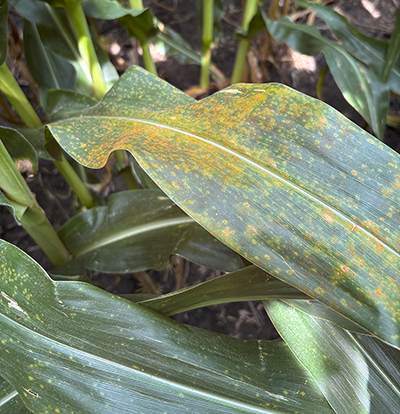Corn diseases and silage implications: what to look for as you prepare for harvest
8/20/25
AMES, Iowa – This summer has been both hot and wet, with consistent rainfall across much of the state. These conditions have led to some unusual challenges in corn fields, including wrapped tassels and southern rust. Both have raised questions about their potential impacts on corn silage.
Wrapped tassels
Wrapped tassels are not a common occurrence in Iowa or the Midwest. As noted by ISU extension cropping systems specialist Mark Licht in this recent ICM blog post, “Are you seeing wrapped tassels shedding pollen? We are, too!" he has only observed this phenomenon once in a 20-plus year career. Yet this year, wrapped tassels have been widely reported across the region.
Wrapped tassels are believed to result from a combination of high temperatures, abundant moisture, and nutrient availability. These conditions can cause the tassel to emerge before the flag leaf has had time to fully unfurl, similar to rapid growth syndrome seen in early vegetative stages.
For silage production as in grain production, the main concern lies in potential pollination problems. Starch content, a key component of silage quality, comes from the ear, so poor pollination can lower starch levels in the final feed. While other nutrient components and total yield are not expected to be significantly affected, there is limited research on its implications due to the rarity of this issue.
Southern rust
Southern rust (figure 1), on the other hand, may pose a more significant risk. Since first being identified in Iowa in July, the disease has spread rapidly under warm, wet conditions. (See more information in this ICM blog post “Southern rust continues to develop across Iowa.”) Southern rust itself does not produce toxins, but it weakens the plant and can open the door for other diseases such as Fusarium and Gibberella stalk rots, which do produce mycotoxins (fumonisin and deoxynivalenol) that are harmful in feed.
These are major concerns of southern rust in silage as outlined in “Effect of Rust Infestation on Silage Quality."
- Early dry down. Early dry down can disrupt the ensiling process. When whole-plant moisture is too low, silage becomes more difficult to pack tightly, which prevents the formation of an ideal anaerobic environment. This increases the risk of poor fermentation, including butyric acid formation, and results in higher silage pH levels.
- Yield loss. While yield impacts are often most evident in grain harvest, silage yield and quality can also be reduced as disease severity increases. Disease pressure in the upper canopy is particularly concerning because it affects grain fill. Since grain contributes most of the starch—and therefore energy—in silage, reduced grain fill can translate to lower starch content in the harvested forage.
- Nutritive value. There was an increase in fiber content, with an up to 13% decline in digestibility in the study above.
Ear rots and other wet-weather diseases
Beyond wrapped tassels and southern rust, the wet conditions this summer have created significant disease pressure overall. Ear rots such as Gibberella, Fusarium, and Diplodia thrive in wet conditions and are especially concerning because of their ability to produce mycotoxins that can impact livestock health.
For more information on identification and management of ear rots, the Crop Protection Network (CPN) provides excellent resources, including the article “An Overview of Ear Rots.”
If you are concerned about disease impacts or potential toxins, getting your silage tested is a smart step to ensure feed safety. The Iowa State University Veterinary Diagnostic Laboratory offers mycotoxin testing. For more details on sampling and submission, see Iowa State University Vet Med – Mycotoxins.
-30-
The Iowa Beef Center at Iowa State University was established in 1996 with the goal of supporting the growth and vitality of the state’s beef cattle industry. It comprises faculty and staff from Iowa State University Extension and Outreach, College of Agriculture and Life Sciences and College of Veterinary Medicine, and works to develop and deliver the latest research-based information regarding the beef cattle industry. For more information about IBC, visit www.iowabeefcenter.org.
Contact:
Shelby Gruss, ISU extension forage specialist, 515-294-3832, sgruss@iastate.edu

